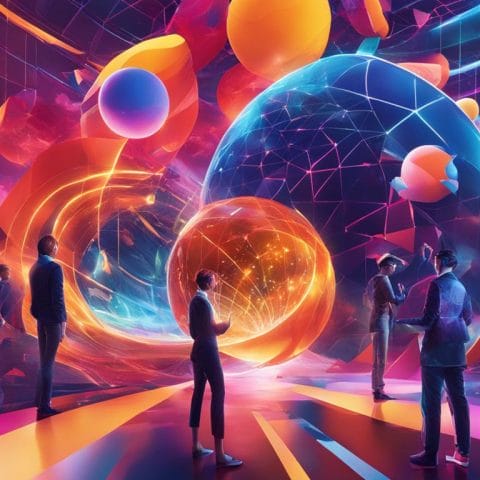The world of eLearning has changed a lot, thanks to AI and immersive tech. Hyperspace brings new tools like soft skills simulations and self-paced learning. These tools include AI avatars that talk and act like real people, and systems that learn and adapt.
AI and immersive tech change how we learn, making it more fun and creative. They let us try new things and learn in new ways. This mix of tech and learning helps us grow and apply what we learn in real life.
Key Takeaways
- AI-powered immersive learning experiences unlock innovative thinking and creativity
- Intelligent systems enhance engagement, personalization, and real-world application of knowledge
- Autonomous AI avatars and adaptive learning scenarios create dynamic, interactive training environments
- Combination of AI and immersive technologies enables efficient creation of custom learning content
- Organizations can leverage AI-driven solutions to transform their training and development programs
What is AI-Powered Immersive Learning?

AI-powered immersive learning combines artificial intelligence with immersive technologies. It creates engaging, hands-on experiences that feel like real life. This method uses virtual reality, augmented reality, and interactive simulations to teach important skills safely.
Definition and Key Concepts
AI-powered immersive learning uses AI to make learning more personal. It analyzes data to adjust content and feedback for each learner. This ensures a better learning experience. AI also helps with interactive dialogues, making learning more interactive and effective.
Importance in Education and Training
AI-powered immersive learning is very important in education and training. It offers many benefits, such as:
- Simulating real-world scenarios for skill development
- Providing timely feedback to reinforce learning
- Enhancing information retention through sensory immersion
- Personalizing the learning experience for different learners
- Encouraging teamwork, critical thinking, and problem-solving
A PwC report shows that VR training makes employees learn four times faster. They also feel more confident in using their new skills. AI-powered immersive learning is changing education and training, preparing learners for the 21st-century workforce.
“AI-powered immersive learning is the future of education and training, opening up new ways to learn and retain knowledge.”
The Role of AI in Enhancing Creativity

Artificial Intelligence (AI) can really boost creativity in learning. It helps by doing the boring stuff, so we can think deeper. This lets us make better choices and adapt to new challenges.
AI Tools that Foster Creative Thinking
New AI tools are changing how we solve problems in school. Tools like Ayoya for brainstorming, Gitmind for team brainstorming, and Innovation Cloud for combining ideas are helping. They let students and teachers explore new ideas and break old rules.
How AI Personalizes Learning Experiences
AI is making learning more personal. It looks at lots of data to find new solutions and speed up solving problems. It makes learning fit each student’s needs and likes.
Also, AI helps in many areas like business and marketing. A study showed that 62% of teachers think students are more creative now because of AI in class. Teachers use tools like School AI, Microsoft Math Solver, Canva, Adobe Express Firefly, and Magic School AI to boost creativity.
It’s important to use AI wisely in school. Teachers need to teach students how to use AI well. With AI, we can help learners be creative and shape the future.
Immersive Learning Environments Explained
The future of learning is all about being immersive. It uses virtual and augmented reality to make learning fun and real. These environments change how we learn, helping us grow in a fast-changing world.
Virtual Reality in Education
Virtual Reality (VR) in schools has really taken off. Devices like Oculus Rift have made it possible. VR lets learners practice real skills safely and learn at their own pace.
It also helps them remember more and feel more connected to what they’re learning.
Augmented Reality Applications
Augmented reality (AR) mixes digital and real-world elements. It makes learning fun and interactive. AR lets learners see complex ideas, interact with virtual objects, and work together in new ways.
It boosts skills like talking and solving problems. This makes AR great for learning and work.
Even though immersive learning works well, some places are slow to adopt it. They worry about cost and time. But as tech gets better and cheaper, more people will see the value of immersive learning.
“Immersive learning allows practice of real-world skills in a safe environment with rich feedback, enabling mastery of behaviors, techniques, or methodologies through guided rehearsals.”
Benefits of Combining AI and Immersive Learning
AI and immersive learning together bring many benefits to education. They make learning fun and effective. With AI-driven education and interactive learning environments, students get a better learning experience.
Enhancing Engagement and Retention
AI makes learning feel like real life. It keeps students interested and helps them remember what they learn. This way, students can use their knowledge in real situations.
Developing Critical Thinking Skills
AI lets students practice solving real-world problems. They learn to think critically and make smart choices. These skills are important for the modern job market.
Fostering Collaboration and Teamwork
AI helps teams work together better. Tools like Slack and Microsoft Teams make sharing ideas easy. This builds a sense of teamwork and community, key for today’s jobs.
| Benefit | Description |
|---|---|
| Engagement and Retention | AI-powered immersive learning creates lifelike situations that captivate learners and enhance knowledge retention through personalized feedback and guidance. |
| Critical Thinking Skills | Interactive scenarios reflecting workplace challenges encourage students to think critically, make decisions, and solve complex problems. |
| Collaboration and Teamwork | AI-driven collaboration platforms enable seamless information sharing and real-time communication, fostering a sense of community and teamwork. |
AI and immersive learning are changing education. They make learning fun and prepare students for the future. Educators can help students reach their full potentials with these technologies.
Real-World Applications in Various Sectors
AI and immersive learning are changing education and corporate training in many fields. In art and design, tools like Canva and Adobe Express help users make professional artwork easily. These AI tools make creating art simpler, letting students and designers explore their creativity better.
In business, VR and AR are used to practice real-world scenarios. For example, Salesforce Einstein automates tasks, making business work more efficient. Robotic Process Automation (RPA) tools also use AI to make routine tasks easier, so employees can focus on important work.
AI in Art and Design Education
AI is changing how art and design are taught. Tools like Canva and Adobe Express use AI to help users create great designs easily. They make it simple for beginners to make stunning art, without needing to know a lot about design.
Business Training Programs Utilizing Immersive Experiences
VR and AR are making business training better. They let trainees practice skills in a safe way. For example, Salesforce Einstein helps employees focus on important tasks by automating some work. RPA tools also make routine tasks easier, making businesses more efficient.
AI and immersive learning are making a big difference in education and business. They help people learn and grow, making them better at their jobs and helping companies succeed.
“AI-powered tools and immersive learning experiences are transforming the way we approach education and training, unlocking new levels of creativity, efficiency, and engagement.”
Overcoming Challenges with AI-Powered Learning
As schools and organizations start using AI for learning, they face big challenges. They need to deal with tech limits and make sure everyone can learn. This means making sure all students can use the new tech.
Addressing Technology Limitations
One big challenge is the tech itself. AI has come a long way, but it’s not perfect. It struggles with things like understanding language and seeing images well. Also, combining different learning tools can be hard.
Companies are working hard to make AI easier to use. They want to make sure it works well for everyone, no matter the size of the school.
Ensuring Accessibility and Inclusivity
It’s important to make sure everyone can learn with AI. This means creating content that fits different students’ needs. Tools like Grammarly help make learning materials better and faster.
The goal is to make it easy for everyone to create and learn. This way, small businesses and individuals can also use AI to bring their ideas to life.
By tackling these challenges, schools and organizations can make AI learning better. They can offer personalized, fun, and fair experiences. This helps students be creative and innovative.
| Challenge | Solution |
|---|---|
| Technology Limitations | Developing user-friendly interfaces and improving hardware capabilities |
| Ensuring Accessibility and Inclusivity | Creating adaptive content and learning pathways, utilizing tools like Grammarly and Hemingway Editor |
“The future of AI in education includes personalized learning at scale, collaborative learning environments, and ethical AI integration to promote inclusivity and fairness.”
Future Trends in AI and Immersive Learning
The mix of artificial intelligence (AI) and immersive tech is changing learning and training. New tech like better language understanding and emotion recognition in AI is making learning more personal and flexible.
Emerging Technologies to Watch
AI tutors are coming that will offer tailored, interactive learning help. These smart helpers will use advanced language skills to talk with learners in real conversations. Also, AI will team up with VR and AR to make learning more fun and interactive, known as gamification in education.
Predictions for the Next Decade
- AI will make VR/AR learning even better, creating real and changing virtual worlds for learning.
- Microlearning, short, focused lessons, will get more popular, helping learners remember up to 80% more than long lessons.
- Haptic tech, which adds touch and feel to virtual worlds, will make training more real, letting learners touch digital objects.
- Learning will get more fun with AI-powered games and rewards, making learners more motivated and engaged.
Looking ahead, AI and immersive tech will keep changing how we learn. They will mix human creativity with AI, leading to new ways of learning and creating in education and training. The change is already happening, with AI and immersive tech setting new standards for learning and growth.
Balancing Creativity and Structure in Learning
In today’s world, finding the right mix of creativity and structure in learning is key. AI tools offer personalized learning and interactive frameworks. But, it’s vital to make sure they help, not block, students’ creative growth.
Finding the Right Blend of Freedom and Guidance
Good AI learning experiences mix structured guidance with room for exploration. For instance, School AI lets teachers create chatbots that act like historical figures or book characters. This method lets students dive into creative roleplay and storytelling, all while learning important skills.
Encouraging Exploration within a Framework
- AI tools give personalized feedback and tips, helping students explore without losing their spark.
- Interactive learning environments powered by AI promote teamwork and diverse views, leading to fresh ideas.
- Personalized adaptive learning algorithms tailor education to each student’s needs, boosting their creative abilities.
AI should support, not replace, human creativity. By balancing structure and freedom, teachers can foster students’ creative talents while meeting learning goals.
“The true sign of intelligence is not knowledge but imagination.”
– Albert Einstein
Measuring Success in Creativity Development
Measuring success in AI-driven education and machine learning pedagogies is complex. We need to look at several factors. These include the quality and number of ideas, how fast learners solve problems, and their ability to use creative solutions in real life. These metrics help us understand how well AI and machine learning work in teaching creativity.
Key Performance Indicators to Consider
- Ideation Metrics: Look at the number and originality of ideas learners come up with. Also, see if they can mix different concepts in new ways.
- Problem-Solving Efficiency: Check how quickly and well learners find and use creative solutions to tough problems.
- Real-World Application: See if learners can use their creative skills and knowledge in real, useful situations.
- Collaborative Creativity: Look at how well learners work together, share ideas, and create together in group activities.
Feedback Mechanisms for Continuous Improvement
Using AI analytics and machine learning, we can create strong feedback systems. These systems help improve creativity programs over time. Tools like Brightidea help gather, sort, and review employee ideas. This gives us data to make the learning content and creative processes better.
| Metric | Description | Sample Measurement |
|---|---|---|
| Ideation Metrics | Check the quality, number, and newness of ideas learners come up with | Number of unique ideas per learner, idea originality scores, idea implementation feasibility |
| Problem-Solving Efficiency | See how fast and well learners come up with creative solutions | Time taken to solve challenges, success rate in using solutions, learner feedback on problem-solving |
| Real-World Application | Measure how well learners use their creative skills in real situations | Learner performance in case studies or real-world projects, feedback from industry partners or clients |
| Collaborative Creativity | Look at teamwork, idea-sharing, and co-creation among learners | Peer feedback scores, team-based project outcomes, learner reflections on working together |
By using these KPIs and feedback systems, we can really understand how well AI education and machine learning pedagogies work. This data helps us keep improving and makes sure learners have the skills they need to succeed in a changing world.
Tips for Implementing AI-Powered Learning in Your Organization
Starting AI-powered learning in your organization means first figuring out what you need and want. Think about the skills you want to teach, how big you want your program to be, and your budget. Look for AI tools that have features like AI avatars, smart responses, and work well with your LMS.
Assessing Your Needs and Goals
First, check what your organization needs to learn and grow. What skills do you want to teach? How big do you want your AI learning program to be? Make sure you have enough money and resources for a good start.
Selecting the Right Tools and Resources
- Find AI platforms with AI avatars that talk like real people and give feedback that fits you.
- Choose tools that understand and respond to your needs for a better learning experience.
- Look for platforms that work well with your LMS to make learning easier.
Start with small learning scenarios that focus on important skills. Use AI to help make content. Make learning fun with sights and sounds. Always ask for feedback to make your learning programs better.
Teach your team how to use AI wisely. Show them how AI can help, not replace, human creativity. With AI learning, you can open up new ways to grow your team’s skills.
“AI can analyze large datasets to uncover patterns and trends that may be difficult for humans to identify, leading to valuable insights and personalized learning experiences.”
Conclusion: Embracing a Creative Future with AI
AI is changing education and training in big ways. It shows how AI can boost creativity in learning. As we look ahead, innovation is key.
AI is making learning more creative and engaging. It’s opening new doors for us to learn and grow.
Final Thoughts on the Importance of Innovation
AI can make us more creative. It’s changing education, helping both learners and teachers. Together, tech and human creativity are creating a new era of learning and innovation.
Encouraging a Culture of Creativity in Learning
To foster creativity, we need to use AI wisely. We must balance tech with teaching methods. AI education is growing, and we should use it to boost creativity and teamwork.
By using AI in learning, we can unlock our full creative power. This will drive innovation in education and beyond.
FAQ
Q: What is AI-Powered Immersive Learning?
A: AI-powered immersive learning uses artificial intelligence and immersive tech like VR and AR. It makes learning fun and interactive. It helps us learn by doing in a safe, controlled way.
Q: How does AI enhance creativity in learning?
A: AI helps us think better and make smarter choices. It frees up time for creative thinking. Tools like Ayoya and Gitmind help with brainstorming and teamwork.
Q: What are the benefits of combining AI and immersive learning?
A: Mixing AI with immersive learning makes learning more fun and effective. It helps us think critically and work better together. It also lets us learn in a way that’s tailored to us.
Q: What are the real-world applications of AI and immersive learning?
A: AI and immersive learning are used in many areas, like art, business, and corporate training. Tools like Canva and Salesforce Einstein are changing how we learn in these fields.
Q: What are the challenges in implementing AI-powered learning?
A: There are tech limits and making sure everyone can access it. Companies are working on making it easier and more accessible. Tools like Grammarly help make learning more open to everyone.
Q: What are the future trends in AI and immersive learning?
A: We’ll see more AI tutors and games in learning. Virtual and augmented reality will get even better. New tech will make learning more personal and effective.
Q: How can organizations effectively implement AI-powered learning?
A: First, figure out what you need and want to achieve. Choose the right AI tools and start small. Use AI for making content and focus on keeping learners engaged. Always ask for feedback to keep improving.





